The death of the 6th army of Paulus
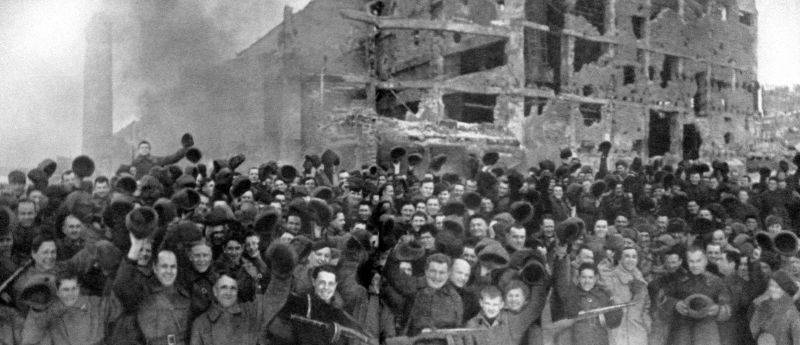
Soldiers of the 95th Infantry Division rejoice in honor of the victory in the Battle of Stalingrad. February 2, 1943
Start of operation
On January 10, 1943, Operation Ring began.How the German "Stalingrad fortress" was stormed). The armies of the Don Front (DF), after a powerful artillery preparation, went on the offensive. Artillery supported the infantry attack and tanks a fiery shaft to a depth of 1,5 km, then moved to accompany them. By the end of the first day, overcoming the fierce resistance of the enemy, the Soviet troops advanced 6–8 km in some sectors. On January 12, having cut off the western ledge of the enemy defense, our troops reached the Rossoshka River. The formations of the adjacent flanks of the 64th and 57th armies, advancing on Basargino, broke through the German defenses on the Chervlyonaya River.
Paulus reported to the high command
The German headquarters ordered with all its might to hold the line of Tsybenko, Karpovka, Rossoshka. Save Nursery. Repulse Tsybenko. But such an order could not change anything. The 6th Army did not have the strength and capabilities for successful counterattacks.
As a result, the task of the first stage of the operation was completed.
The 29th motorized and 376th infantry divisions were completely destroyed. The retreating German troops, due to lack of fuel, abandoned equipment and heavy weapons. The starving and freezing Germans no longer had the strength to build new positions in the winter, to hollow out the frozen ground. Therefore, shelters were erected from snow, ice and the bodies of the dead.
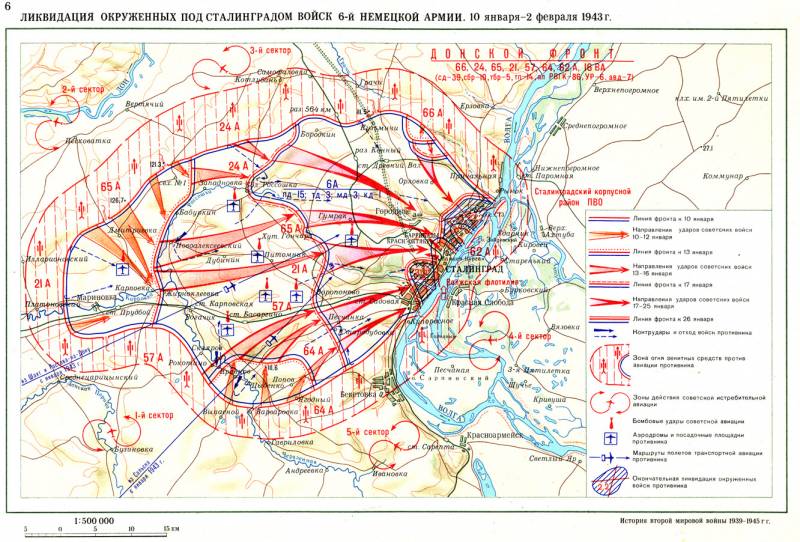
The position of many Red Army soldiers was about the same. The fighting went on day and night. The soldiers were out in the open, freezing and unable to wash themselves. The quartermasters got lost or fell behind, the soldiers were left without food, they were interrupted by the remnants. There was no firewood to keep warm, the soldiers climbed into pits, funnels, covered themselves with raincoats, burned something. There were cases where they got lost. But, unlike the Nazis, our soldiers had winter uniforms, and they had no problems with ammunition. Shells and cartridges were delivered in the first place, they were not spared.
By the end of January 17, the Soviet divisions advanced to the line of Bolshaya Rossoshka - the farm of Gonchar - Voroponovo. Here the Germans entrenched themselves on the inner contour of the city fortifications. The front line was reduced from 170 to 110 km. The territory of the defended area has decreased by half. The main airfield in the Pitomnik area became a big loss for the 6th Army, and a field hospital was also located there. Paulus' headquarters moved from Gumrak closer to Stalingrad.
Having lost hope for outside help, the remnants of the German battalions began to surrender. But most of the troops, despite the hopelessness of the situation, still fought stubbornly. Soviet intelligence reported that the daily ration of the Germans was reduced to 150 grams of bread, 60-75 grams of meat and horse meat soup, occasionally 25-30 grams of butter. Also, from the interrogation of the prisoners, it turned out that initially not 90 thousand soldiers and officers of the enemy, but more than 200 thousand were caught in the encirclement.
The Germans stubbornly resisted.
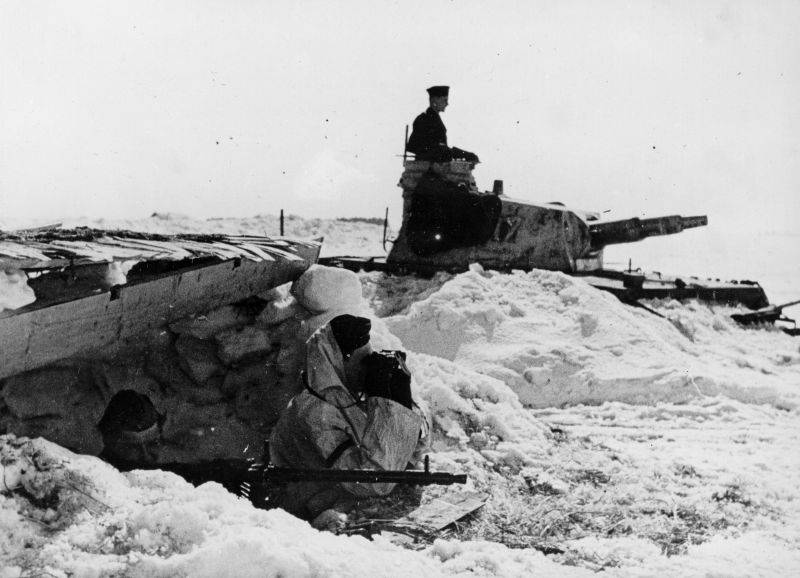
German tank Pz. Kpfw. IV Ausf. F1 in positions near Stalingrad. In the foreground is a machine gunner armed with a MG 34
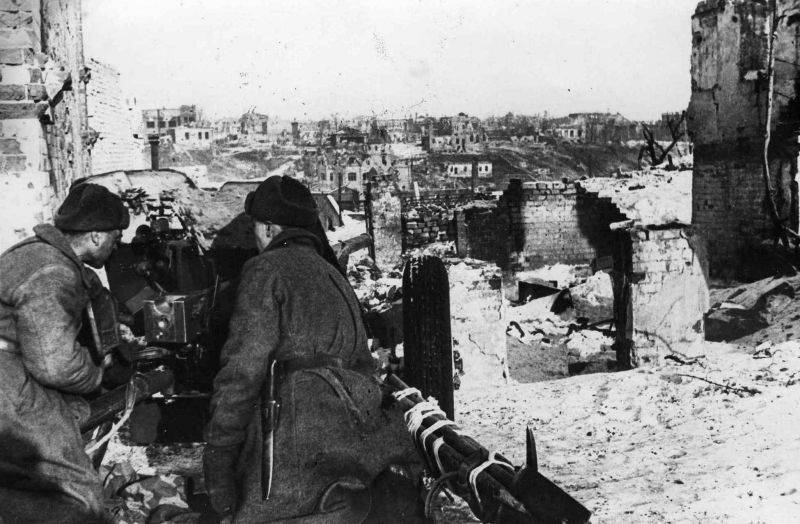
The calculation of the Soviet 45-mm gun is firing in the area of the confectionery factory in Stalingrad. January 1943
The dismemberment of the German group
The Soviet command decided to take a short break and suggested that the Nazis lay down weapon. But this time, too, the offer of surrender was rejected. Rokossovsky's troops began preparing the final assault.
Paulus, in order to continue the defense, asked Manstein to urgently transfer several battalions by air, but the German command was not going to transfer reinforcements of the doomed 6th Army. Every day, while the army of Paulus was fighting, he held back the Russian armies near Stalingrad, allowed the Germans to improve the situation in other directions. Therefore, Hitler ordered the battle for Stalingrad to continue until the last opportunity.
On January 22, 1943, the final stage of the operation began.
Thousands of guns and mortars paved the way for the Soviet divisions. This time, Chistyakov's 21st Army dealt the main blow. Soviet troops advanced 10-15 km in four days with fierce battles, occupied Gumrak, the last German airfield. The remains of the air bridge collapsed. Now the supply of the 6th Army was completely carried out by dropping containers by parachute. Their contents - provisions, warm clothes and shoes - were a valuable trophy for our soldiers. So they fired salvaged flare guns to capture the good that was being dropped.
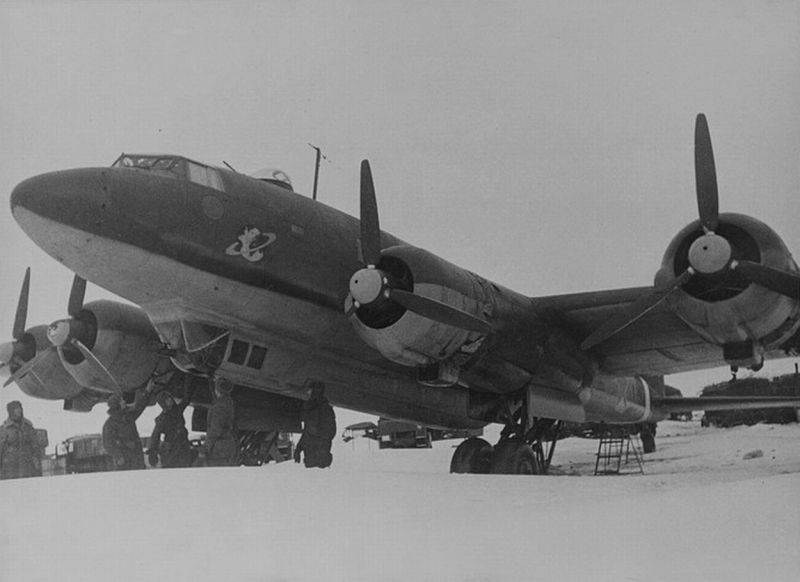
German long-range reconnaissance bomber Focke-Wulf Fw. 200 "Condor", captured by Soviet troops at the Pitomnik airfield (Stalingrad region). January 1943
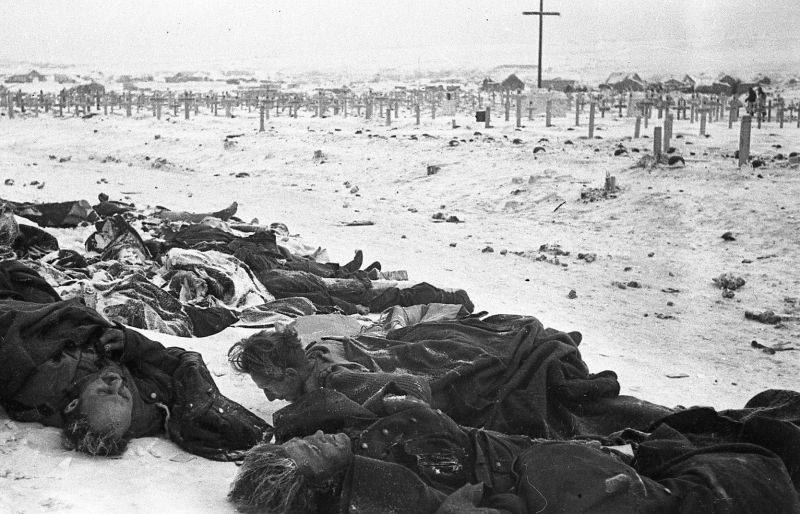
The bodies of Wehrmacht soldiers near the German cemetery in the village of Gorodishche near Stalingrad.
The front came close to the city, where there were still up to 100 thousand German soldiers. On January 24, Paulus reported to the command:
The commander of the 6th Army asked to be given freedom of action to try to break through to the southwest, or stop the fight.
Hitler replied that surrender was out of the question and
On January 25, units of the 65th Army occupied Aleksandrovka and Gorodishche, the troops of the 64th and 57th armies, advancing from the south, defeated the enemy in Kuporosny, Elshanka, Peschanka, at Voroponovo and Sadovaya stations. The territory occupied by the Nazis was reduced - from north to south it was 20 km, from west to east - 3,5 km. Soviet troops reached the outskirts of the city. There were street fights.
From that day on, the headquarters of the 6th Army was located in Stalingrad in the basement of a department store building. To his generals, who expressed doubts about the need for further resistance, Paulus replied:
On the morning of January 26, formations of the 21st Army, splitting the cauldron in two, met in the area of the village of Krasny Oktyabr and Mamaev Kurgan with units of the 13th Infantry Division of the 62nd Army. The German garrison was divided into a southern group - in the city center (the remnants of 9 divisions under the formal command of Paulus), and a northern one - in the area of \u12b\u11bthe Barricades and tractor factories (the remnants of XNUMX divisions led by the commander of the XNUMXth Corps, General Strecker).
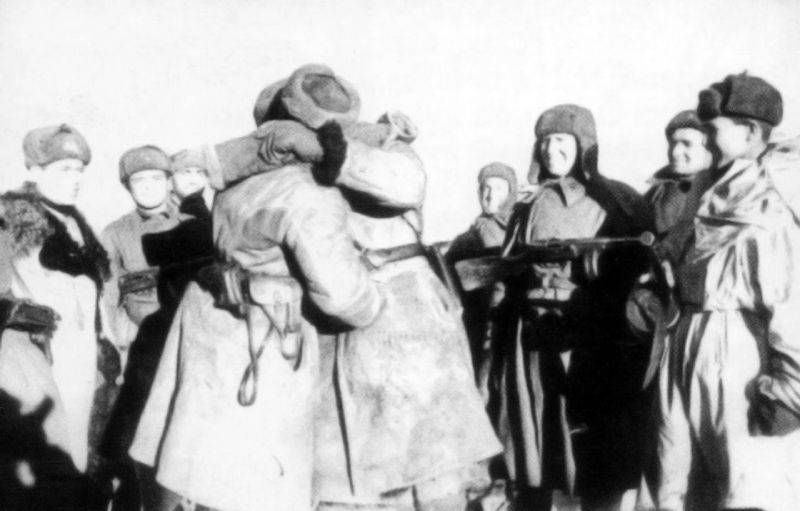
Meeting of fighters of the 21st and 62nd armies on the northwestern slopes of Mamaev Kurgan. January 26, 1943
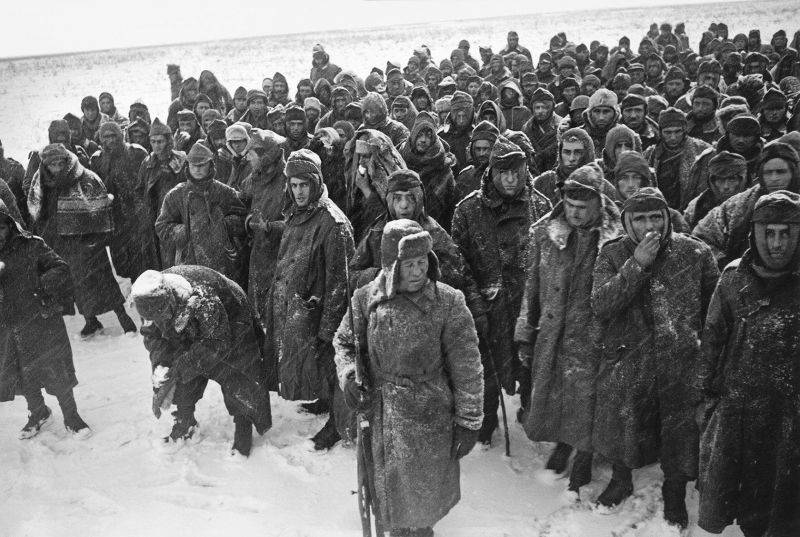
A group of Italian soldiers captured near Stalingrad
Surrender
From January 27, 1943, there were battles to eliminate two German groups.
The troops of the 64th, 57th and 21st armies began to liquidate the southern grouping. The Nazis continued to resist. There were street fights. Soviet artillery, except for the regimental artillery, ceased fire in the southern part of the city, as the shooting was dangerous for their own troops. On the night of January 29, units of General Shumilov's 64th Army crossed the Tsaritsa River and entered the city center. On January 30, the troops of the 64th and 57th armies, having dismembered the enemy's southern grouping, came close to the city center. The 21st Army advanced from the northwest.
On January 30, the Third Reich celebrated the tenth anniversary of Hitler's appointment as Chancellor of Germany. On this occasion, four generals, including Friedrich Paulus, were awarded the rank of field marshal. This news the commander of the 6th Army was handed over in the morning of the next day. Paulus realized that he was offered to commit suicide. But he didn't shoot. Three hours later, soldiers of Colonel Burmakov's 6th Motorized Rifle Brigade “knocked” at the door of the headquarters of the 38th Army. The first German field marshal, one of the authors of the famous Barbarossa plan, surrendered to Russian captivity. The southern grouping of the German Stalingrad fortress ceased resistance.
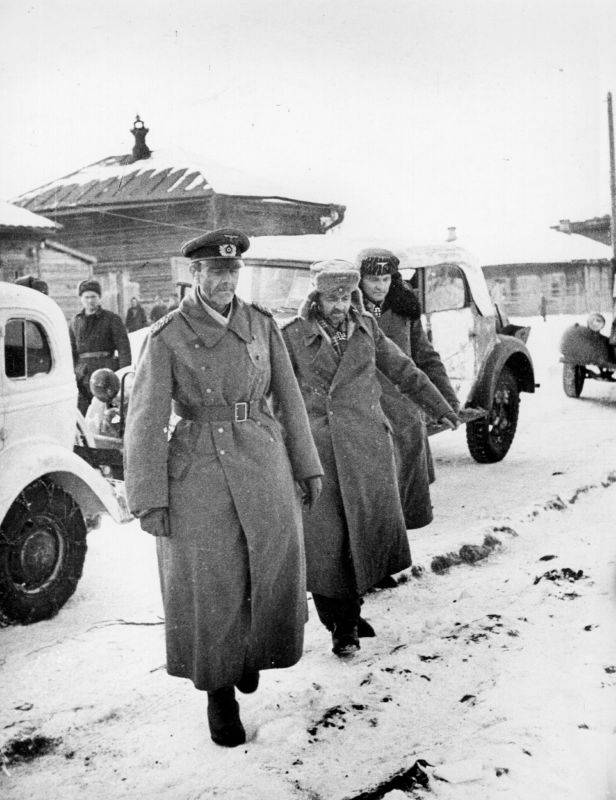
Field Marshal Friedrich Paulus (left), commander of the 6th Wehrmacht Army encircled in Stalingrad, his chief of staff, Lieutenant General Arthur Schmidt, and his adjutant Wilhelm Adam after surrendering. Stalingrad, Beketovka, headquarters of the Soviet 64th Army. January 31, 1943
Strecker's northern group refused to lay down their arms and continued to resist. She had to be beaten. The task was solved by the troops of the 62nd, 65th and 66th armies. Rokossovsky, in order to reduce losses, pulled numerous artillery units here. Large air force forces were also involved. In some places, the guns were placed almost close and in two lines. The artillery worked all night. On the morning of February 1, a powerful artillery preparation began. She walked only 15 minutes. The remaining Nazis could not stand it. Almost immediately after the start of the artillery preparation, white flags began to appear. But the foci of the Nazis snarled for another day. On the morning of February 2, 1943, the remnants of the northern group capitulated. Over 40 thousand soldiers, led by General Strecker, laid down their arms.
Some Nazis preferred death to captivity. The commander of the 371st Infantry Division, General Shtempel, shot himself. Someone in small groups tried to pass through the snow-covered steppe to the southwest. Someone tried to hide. These were caught until February 22. But no one left the ring.
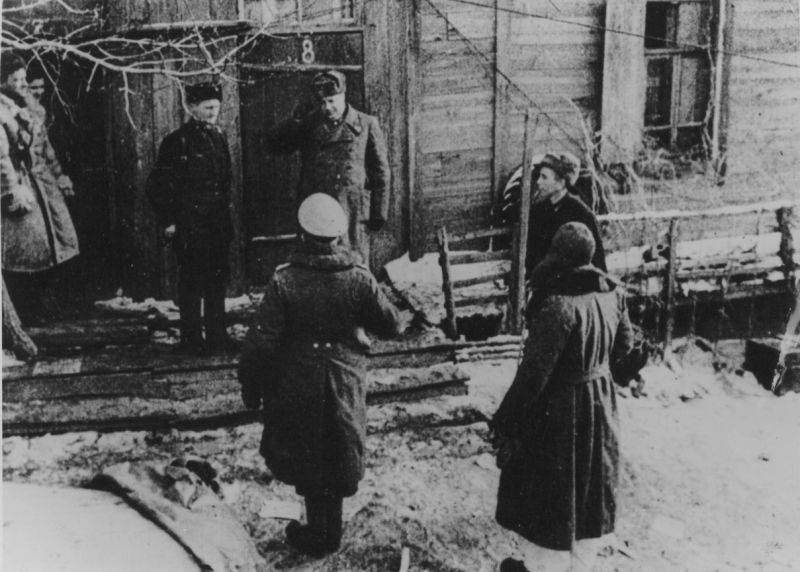
The commander of the 11th Wehrmacht Army Corps, Colonel General Karl Strecker (standing with his back in the center left) surrenders to the representatives of the Soviet command in Stalingrad. February 2, 1943
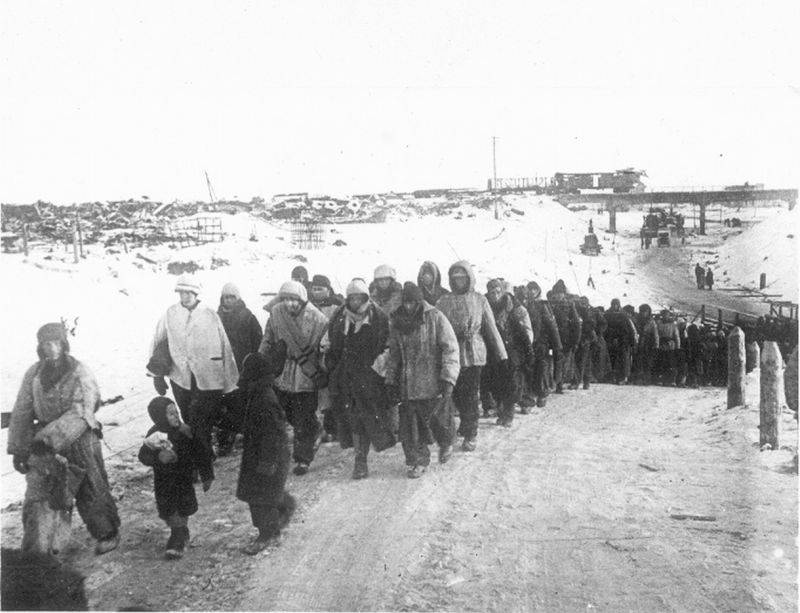
Captured Germans from the 11th Army Corps of Colonel General Karl Strecker, who surrendered on February 2, 1943. District of the Stalingrad Tractor Plant
Results
The great battle on the Volga is over.
The Germans lost up to 90 thousand prisoners, 140 thousand were killed, froze. Several thousand were able to evacuate by air.
The Russians treated the prisoners quite humanely. But the mortality among the prisoners, exhausted by hunger, disease and the wounded, was high.
Paulus:
The total losses of the Soviet troops of the Don Front for the period from January 1 to February 15, 1943 amounted to over 100 thousand people.
An enraged Hitler swore that until the end of the war he would no longer confer the rank of field marshal on anyone else (he lied). There was three days of mourning in Germany. All entertainment establishments were closed, they listened to Wagner's music. German society was stunned and began to realize the gravity of the war.
The historical and strategic significance of the Battle of Stalingrad was enormous. The war was a turning point. 5 enemy armies were defeated. The Battle of Stalingrad strengthened the authority of the USSR as the leading force in the fight against Nazism and fascism. In the USSR itself, faith in the final victory over the enemy was strengthened. The defeat at Stalingrad caused internal crises in Italy, Hungary and Romania.
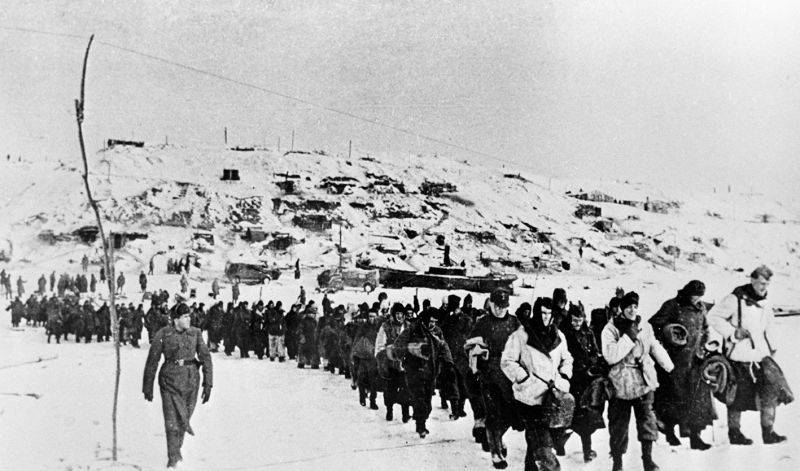
A column of German prisoners of war on the banks of the Volga River, behind the Krasny Oktyabr plant
Information